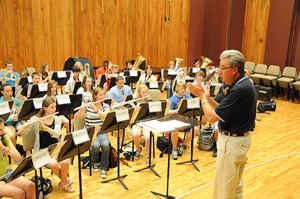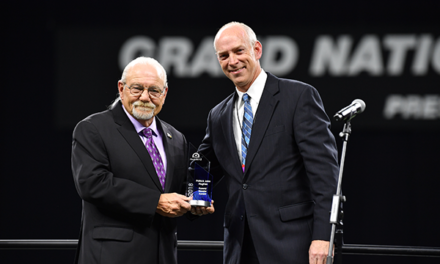 This morning when I woke up, I realized that it was the last full day of camp, excluding the Saturday performances, of course. My first thought was – there’s still so much I want to see!
This morning when I woke up, I realized that it was the last full day of camp, excluding the Saturday performances, of course. My first thought was – there’s still so much I want to see!
I ended up visiting several tracks early on this morning, but before I get to that, let me fill you in on the concert band track. Last night, I was lucky enough to have a bit of time to stop by and hear the end of the “Oklahoma” Concert Band’s rehearsal.
The band is conducted by Dr. Joseph Missal, who is celebrating his 25th year as Director of Bands and Professor of Music at Oklahoma State University. Dr. Missal also directs the graduate conducting program, teaches undergraduate conducting, and serves as Area Coordinator for the Wind and Percussion Division.
“Practice like you’re going to perform,” Dr. Missal instructed the students.
The band was getting ready to rehearse “Resonances I” by Ron Nelson. I noticed when looking over the shoulder of a student percussionist that the piece is divided into six parts – Unit I, II, III, IV, V and VI. After researching later, I learned that the six parts of this work are made up of “boxes of activity,” and the duration of each section is determined by the conductor. The title makes sense – each instrument has seemingly independent lines that explore different textures and eventually all come together in a cacophony of sound that ends with a mighty, percussive crash.
After the band finished the piece, the bell sets rang on for a moment in the suddenly quiet room. The band waited patiently for the sound to fade away.
“Our goal is to be the best we can be,” Dr. Missal said. “If it’s not about music, it’s not worth doing. I’m so proud of you, but I’m not done [working] with you yet. We’ll take this [music] to another level.”
I chatted briefly with Hunter, a percussionist, on my way out. I asked if he was having a good time this week. He told me it was his first time at camp, and he said it’s been a great experience. He also told me that was really happy with the pieces the band has been rehearsing, and I hope to be able to hear their repertoire in full tomorrow at the final performances.
The morning was a great time for me to visit student tracks. First, I stopped to see the Jazz students. I watched Rex Richardson take the band through rehearsal. Richardson is rated by musicians and critics as being “among the very best trumpet soloists in the world today,” (ITG Journal, Jan. 2011). He cleaned some specific sections and was working with the trombone section as I walked in.
It was fun to listen to Richardson work with Adam, the student playing Drum Set. He instructed Adam to play a drumbeat that was a total contrast to what the horns were doing. The horns were swinging, and Adam played an almost march-like beat. The contrast was a completely unique, interesting sound, and it worked so well! As Richardson put it, “I really like that. It’s kind of goofy, but it’s supposed to be.”
I’m constantly reminded of the musical maturity of these students. One student mentioned that he thought the ensemble needed to go back and work on measure 110 again. Richardson agreed. That kind of maturity is impressive – the fact that students can hear those issues and know how to solve them is amazing.
As I headed out, I took a look at my schedule and realized the Percussion Ensemble students were also rehearsing in the same building. I found them discussing cymbal crashes. It was very interesting to hear about how different types of cymbals affect the sound.
I learned that there are specific cymbals that fit different pieces of music. The discussion turned to how cymbals used to be classified by three weights – French, Viennese and Germanic. Different cymbals produce different sound characteristics, which I guess I always knew, but I hadn’t really thought about it in depth before. I thought it was really helpful and unique that the students learned how the dimensions and thickness affect the sound. It really gives a true understanding of what is happening when they play, which is important.
It was starting to look a bit cloudy, but I was energized from the jazz and percussion sessions so I thought I’d brave the potential weather and wander over to see the color guard. I’m so glad I did – they were rehearsing on the quad for their final performance tomorrow, and they were phenomenal to watch!
Melanie Glazer, senior SWAG for the Color Guard Division, told me that Carolina Crown’s guard worked with the students earlier in the day. As I watched the guard students practice, Glazer told me that the first two days of the track, students worked on a routine that they then performed for each other and for directors on Wednesday evening. Then they worked on their final routine, which they’ll perform tomorrow.
Students have also experienced advance technique classes with Vincent Thomas, Associate Professor of Dance at Towson University in Maryland. Students worked in their individual sections as well (flag, rifle or sabre), and they also had leadership classes each day. Additionally, they had the opportunity to take elective classes and work on partner tricks, basic skills on another piece of equipment, or attend a session on how to audition for Drum Corps.
It was great to see the students out on the spacious quad rehearsing, and I know their performance tomorrow will be wonderful.
The Drum Corps International show is happening right now! I was out there earlier tonight and had a chance to see some corps as well as the Marching Band Track students. The Marching Band students performed the National Anthem, and they’ll also perform later tonight with Carolina Crown. The students have been rehearsing and performing with Carolina Crown throughout the week in preparation for the DCI Central Indiana show tonight at Scheumann Stadium.
I’m looking forward to the final concerts tomorrow!
Musically,
Kristin



